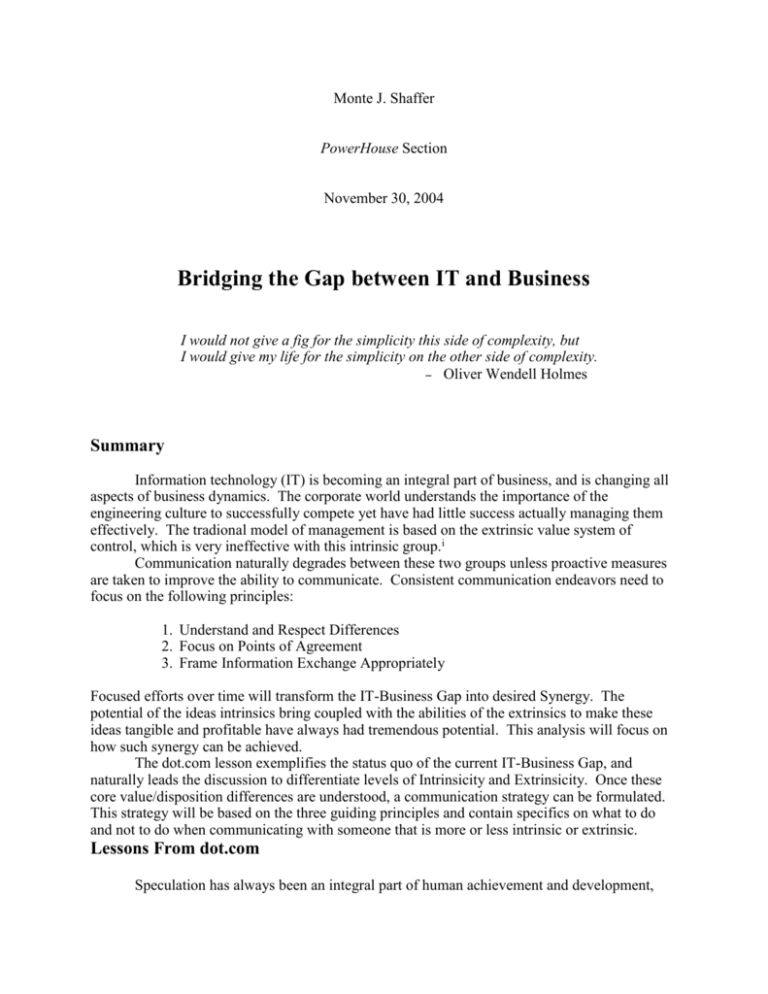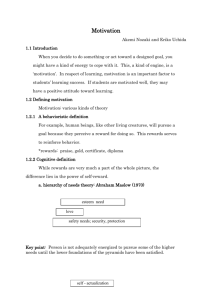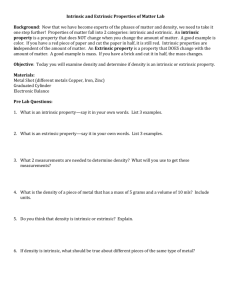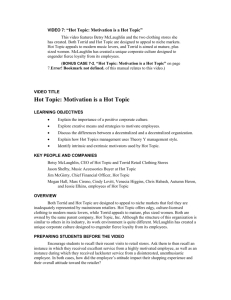Intrinsicity - Applicant seeking PhD in Marketing :: Monte Shaffer
advertisement

Monte J. Shaffer PowerHouse Section November 30, 2004 Bridging the Gap between IT and Business I would not give a fig for the simplicity this side of complexity, but I would give my life for the simplicity on the other side of complexity. – Oliver Wendell Holmes Summary Information technology (IT) is becoming an integral part of business, and is changing all aspects of business dynamics. The corporate world understands the importance of the engineering culture to successfully compete yet have had little success actually managing them effectively. The tradional model of management is based on the extrinsic value system of control, which is very ineffective with this intrinsic group.i Communication naturally degrades between these two groups unless proactive measures are taken to improve the ability to communicate. Consistent communication endeavors need to focus on the following principles: 1. Understand and Respect Differences 2. Focus on Points of Agreement 3. Frame Information Exchange Appropriately Focused efforts over time will transform the IT-Business Gap into desired Synergy. The potential of the ideas intrinsics bring coupled with the abilities of the extrinsics to make these ideas tangible and profitable have always had tremendous potential. This analysis will focus on how such synergy can be achieved. The dot.com lesson exemplifies the status quo of the current IT-Business Gap, and naturally leads the discussion to differentiate levels of Intrinsicity and Extrinsicity. Once these core value/disposition differences are understood, a communication strategy can be formulated. This strategy will be based on the three guiding principles and contain specifics on what to do and not to do when communicating with someone that is more or less intrinsic or extrinsic. Lessons From dot.com Speculation has always been an integral part of human achievement and development, both in speculative successes and failures. History demonstrates that endeavors such as trying to build a tower to heaven, exploring to find a trade route to China, seeking alternative routes to the Indies, etc., are all beneficial in the advancement of civilization. Some speculations are downright absurd. Historically, the dot.com bubble can arguably be evaluated as being more absurd than selling a single tulip bulbs for $150,000 each. Investors threw money at any and all Internet or Tech opportunities, some investing in a stock because it had a similar name or symbol than a perceived valuable stock.ii The Internet became the greatest thing since sliced breadiii, and its potential for changing the world of business outstripped its practical development. “First to Market” was the key to tapping this great potential. Billions of dollars were spent on every imaginable “start-up” idea, inventing the “new economy” term “burn rate.” Companies paradoxically would lose millions every quarter as their momentum and value increased. Perception of innovation dominated, whereas the actually technologies lagged. Like all speculative bubbles, the dot.com bust revealed the facade behind most Internet companies. Many 28-year old “paper millionaires” had to return their leased BMWs, and try to figure out how to find a real job. Few companies survived. How did this occur? The demise of the dot.com facade was an inevitable result of its creation. Generation X hit the workforce with great confidence. Some of this generation worked the back office, creating innovative technologies (“IT”). The hype, however, did not generally come from this group. Rather, the business-savvy Gen-X crowd (“Exploiters”) pitched these visionary ideals to a less tech-savvy group – traditional managers and investors (“Business”). This framework for communication allowed the facade to be perpetuated much longer than reason should have allowed. Investors got “milked” for another round of VC as progress reports on the technology development were often exaggerated. This cycle occurred until the coffers were emptied and the companies started to burst—one by one. The most devastating impact of this speculative time was the division it created between the two necessary components for any successful venture today: IT and business. Although technology has become an integrated part of the global business fabric, a chasm of communication has been created between IT and business. Natural power struggles occurred between these two groups: IT sought respect for their ideas and intelligence; Business sought money and power. Bridging The Gap Naturally, the differences in culture makes communication between the two groups very difficult. Cultural differences are a combination of a person's values, dispositions (both wired and acquired), and motivations. Current communication is truly nonexistent until the friction between the two build into a shocking level of communication, which can be analogized to how electricity is transferred across a capacity, a truly shocking experience. With some efforts, communication can occur, but generally, this requires filtering; that is, only listening to what one wants to hear, ignoring other information that doesn't fit to the listener's core culture. This can be analogized to how electricity is transferred across a resistor, a drop in information exchanged. As each group's culture is understood, communicating can become a more effective experience. Again, this can be analogized to how electricity is transferred across a inductor, the entire message goes with with a bonus feedback message. This type of communication requires consistent effort, and over time can transform the communication relationship. This can be analogized to how electricity is transferred across a transformer, major synergistic levels of information is exchanged. The first step to achieve such transforming success is to understand the differences between the two groups, the traditional extrinsic business culture and the intrinsic value system, truly comparing apples and oranges. Intrinsicity Instrinsicity refers to internally driven values, motivations, and behaviors. This is not to be confused with introversion; introversion is about social interaction tendencies, intrinsicity is about principle driven actions. Albert Einsten describes his intrinsicity: “Two things inspire me to awe – the starry heavens above and the moral universe within.”iv This describes the essences of intrinsic values – desire to contribute to society with given intellect and an understanding of this contribution to the internal self. Such intrinsic values can be summarized below: ● ● ● ● ● Altruistic Intangible / Theoretical World Idea Driven Visionary Optimum Position has Functional Meaning Power is based upon “comparative” relationships to other intrinsics in terms of contribution. These values are core to intrinsic behavior and will not or can not change. These values must be understood and if carefully managed, can be framed to create synergistic relationships with the extrinsic. Such values are difficult for the extrinsic to understand, so an examination of some core behaviors and motivations can clarify: ● ● ● ● ● Time is relative and has no significant meaning Goals are based upon solving problems, making the world a better place, contributing to the common good Justice and Moral Authority are fundamental measures of Respect Physical and Legal ownership is of little import Contributions are minimized and qualified when compared to the whole Such an examination many times exacerbates the extrinsic mind because many of the values, behaviors and motivations are in direct conflict with extrinsicity. Such conflict has significant impact on both the intrinsic and extrinsic, and can be illustrated from the life and death of Archimedes, a true intrinsic. In 287 B.C., the son of the astronomer Phidias, and a relation to King Heron II of Syracuse, Archimedes was born into opportunity. However, he did not seek such things; rather, he spent his life studying the internal world. He was the master geometrician of his day, proving that the volume of a sphere was equal to the sum of the volume of the cone and cylinder with similar radii. He also introduced the concept of large numbers with estimating calculations to determine the number of stars in the heavens and sands along the seashore. Further, he used “methods of exhaustion” to get a very accurate estimate for PI as the fraction 22/7. It also cannot be forgotten how he won the heart of his family friend. While pondering on how to determine if Heron's crown was pure gold, he took a public bath, discovered water displacement, exclaimed “Eureka!” as he ran naked through the streets. Such a brilliant mind could not be wasted. He took his ideas and created experimental projects which intrigued his relation, King Heron II. One of his first practical devices is still used today in desert communities to efficiently draw want from a well, known as Archimedes' screw. Archimedes demonstrated practical applications of levers and pulls by lifting an entire ship from the water, from which comes the expression, “Give me a lever long enough and a fulcrum on which to place it, and I shall move the world.” King Heron II convinced Archimedes to build war machines and contraptions (such as catapults, grappling hooks, levers and pulleys) which helped Syracuse defend itself from the first wave of invasions from the Roman attacks led by Marcellus. Such ingenuity did not go unnoticed, so in the following attacks, Roman soldiers were given the explicit instructions to capture Archimedes alive. Archimedes ... was ..., as fate would have it, intent upon working out some problem by a diagram, and having fixed his mind alike and his eyes upon the subject of his speculation, he never noticed the incursion of the Romans, nor that the city was taken. In this transport of study and contemplation, a soldier, unexpectedly coming up to him, commanded him to follow to Marcellus; which he declining to do before he had worked out his problem to a demonstration, the soldier, enraged, drew his sword and ran him through. v The death of Archimedes demonstrates his intrinsic nature, and focus on ideas rather than realities. His legendary last words “Noli turbare circulos meos” (don't disturb my circles) baffles the extrinsic yet is still extolled by the intrinsic. Extrinsicity Extrinsicity refers to outwardly driven values, motivations, and behaviors—again not to be confused with extroversion. Andrew Carnegie describes his extrinsicity: “Immense power is acquired by assuring yourself in your secret reveries that you were born to control affairs.”vi This describes the essences of extrinsic values – desire to control the affairs of society and lead human achievement forward based on these driving values. Such extrinsic values can be summarized below: ● ● ● ● ● Darwinistic Tangible / Physical World Task Driven Local Optima Position has Power Meaning Power is based upon “additive” extrinsic values of Wealth / Influence These values are core to extrinsic behavior and will not or can not change. These values must be understood and if carefully managed, can be framed to create synergistic relationships with the intrinsic. Such values are difficult for the intrinsic to understand, so an examination of some core behaviors and motivations can clarify: ● ● ● Time is of the essence Goals are based upon gaining Wealth, Power, and Influence Social Position is fundamental measure of Respect ● ● Protecting and Preserving Achievements are Essential Benchmarks of success are maximized and quantified based on Positions and Salaries Such stark differences define the essence of the natural inabilities for these two groups to communicate. Communication is worthwhile, with huge potential for creating what can not be created in isolation, yet requires focused and consistent effort. Communication Principles Understanding the conflicting values between the intrinsic and extrinsic is the first step in bridging the gap of intercommunications. The second element of this step is to truly respect such differences for what they are, and manage the differences with an understanding that these core cultural values can not be changed, and dispositions most likely will not change. The next step for creating an environment for effective communication is to focus communication exchanges around points of agreement. This will better prepare the sender of the information to frame the communication in a way that will be more effectively accepted by the receiver. To achieve these principled outcomes, the communicator needs to understand where they live on the Intrinsic-Extrinsic Spectrum in relation to the communicatee. If the communicator is more extrinsic in the informational theme, then it is essential to frame the communication to be received by someone more intrinsic. Obviously, the reciprocal is also true. The colored appendix gives some clearly defined DOs and DONTs to create effective communication. iThe Dictatorship of High-Tech Management. See p.81, High-Tech Betrayal: Working and Organizing on the Shop Floor, Victor G. Devinatz. (Michigan: Michigan University Press, 1999) iiThe tulip was much more tangible than vaporware, see http://www.itulip.com/knowyourmania.html for more information. iiiThe town of Chillicothe, Missouri claims to be the first town to coin this phrase (See http://www.kansascity.com/mld/kansascitystar/6405440.htm?1c) ivhttp://www.thinkexist.com/English/Author/x/Author_1082_2.htm vMuch of this research and story came from my previous life as a Math instructor, details from his life can be found here: http://www-gap.dcs.st-and.ac.uk/~history/Mathematicians/Archimedes.html http://www.mcs.drexel.edu/~crorres/Archimedes/Death/Histories.html http://www.1famousquote.com/a/archimedes-1.htm vihttp://www.motivatingquotes.com/control.htm






